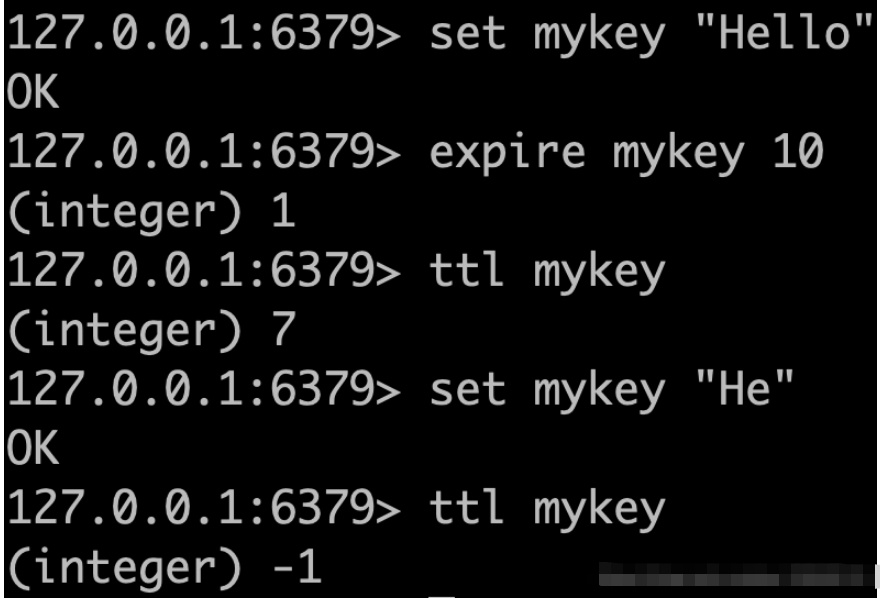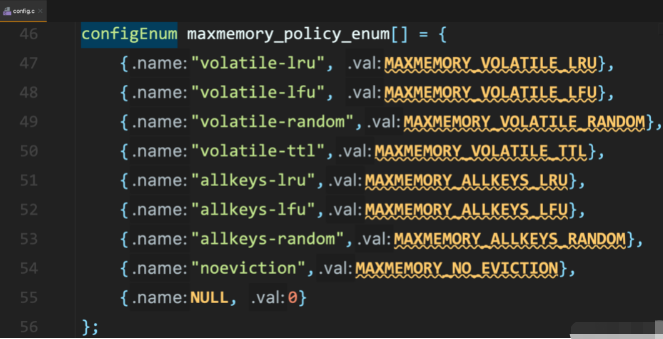How to use Redis's expiration strategy and memory elimination strategy
1 Set the key with expiration time
expire key seconds 时间复杂度:O(1)
Set the expiration time of key. After timeout, the key will be automatically deleted. In Redis terminology the associated timeout for a key is volatile.
After timeout, it will only be cleared when DEL, SET, or GETSET is executed on key. This means that conceptually all operations that change the key without replacing it with a new value will keep the timeout unchanged. For example, use INCR to increment the value of key, execute LPUSH to push the new value into the list or use HSET to change the field of the hash, These operations all leave the timeout unchanged.
Use the
PERSISTcommand to clear the timeout and make it a permanentkeyIf
keyis modified by theRENAMEcommand, the related timeout period will be transferred to the newkey- ##if
key
is modified by theRENAMEcommand. For example,Key_Aoriginally existed, and then theRENAME Key_B Key_Acommand is called. At this time, the originalKey_A## is ignored. # Whether it is permanent or set to timeout will be overwritten by the validity status ofKey_B Note that EXPIRE/PEXPIRE is called with a non-positive timeout or with a past time EXPIREAT/PEXPIREAT will cause the key to be deleted rather than expired (so the key event emitted will be del, not expired).
1.1 Refresh the expiration time
Performing the
EXPIRE operation on the key that already has an expiration time will update its expiration time. There are many applications with this business scenario, such as session recording. 1.2 Differences in Redis before 2.1.3
In Redis versions before 2.1.3, changing a key with an expired set using the command that changes its value has the effect of completely deleting the key. This semantics is required due to limitations in the now-fixed replication layer.
EXPIRE will return 0 and will not change the timeout for keys with a timeout set.
1.3 Return value
- 1
If the expiration time is successfully set.
- #0
If
keydoes not exist or the expiration time cannot be set. 1.4 Example
 Suppose there is a Web service that is interested in the latest N pages recently visited by the user, so that each adjacent Page view is no more than 60 seconds after the previous page. Conceptually, think of this set of page views as a navigation session for the user, which might contain interesting information about the products they are currently looking for so that you can recommend related products.
Suppose there is a Web service that is interested in the latest N pages recently visited by the user, so that each adjacent Page view is no more than 60 seconds after the previous page. Conceptually, think of this set of page views as a navigation session for the user, which might contain interesting information about the products they are currently looking for so that you can recommend related products.
This pattern can be easily modeled in Redis using the following strategy: Every time the user executes a page view, you call the following command:
MULTI RPUSH pagewviews.user:<userid> http://..... EXPIRE pagewviews.user:<userid> 60 EXEC</userid></userid>
If the user is idle for more than 60 seconds, then Delete the key and only record subsequent page views that differ by less than 60 seconds. This mode is easily modified to use INCR instead of a list using RPUSH.
1.5 Key with expiration time
Normally, a Redis key is created without an associated survival time. The key will persist unless the user deletes it explicitly (such as the DEL command). Use the EXPIRE command to associate an expired item with a given key, but this will cause the key to occupy additional memory. Redis will automatically delete keys with expired sets after a specified time to ensure that the data does not expire. The critical time to live can be updated or completely removed using the EXPIRE and PERSIST commands (or other strict commands).
1.6 Expiration precision
The expiration time in Redis 2.4 may not be precise, fluctuating between 0 and 1 second. Since Redis 2.6, the expiration error ranges from 0 to 1 milliseconds.
1.7 Expiration and persistence
Store the key of expired information as an absolute Unix timestamp. The millisecond-level storage method is suitable for Redis version 2.6 and higher. This means that time is flowing even when the Redis instance is not active. For expiration to work well, the computer time must be stabilized. If you move an RDB file from two machines that have large desyncs in their clocks, interesting things may happen (like loading all keys that are out of date). Even when running an instance, the computer clock is always checked, for example, if you set a key to 1000 seconds and then set the computer time 2000 seconds in the future, the key will expire immediately instead of lasting 1000 seconds.
2 How to expire keys in Redis
There are two ways to expire keys: passive way - lazy deletion, active way - regular deletion.
2.1 Lazy deletion
When the client tries to access the key, the key will expire passively, that is, Redis will check whether the key has an expiration time set, and if it expires, it will be deleted. Return nothing. Redis will not automatically delete the key, but when querying the key, Redis will lazily check whether it has been deleted. This is similar to Spring's delayed initialization.
当然,这是不够的,因为有过期的key,永远不会再访问。无论如何,这些key都应过期,因此请定期 Redis 在具有过期集的key之间随机测试几个key。已过期的所有key将从key空间中删除。
2.2 定期删除
具体来说,如下 Redis 每秒 10 次:
测试 20 个带有过期的随机键
删除找到的所有已过期key
如果超过 25% 的key已过期,从步骤 1 重新开始
这是一个微不足道的概率算法,基本上假设我们的样本代表整个key空间,继续过期,直到可能过期的key百分比低于 25%。在任何特定时刻,已失效的最大键数等于每秒最大写入操作数除以4,这是由内存使用所决定的。
2.3 在复制链路和 AOF 文件中处理过期的方式
为了在不牺牲一致性的情况下获得正确行为,当key过期时,DEL 操作将同时在 AOF 文件中合成并获取所有附加的从节点。这样做的好处是能够将过时的处理过程集中在主节点中,避免出现一致性错误的可能性。
但是,虽然连接到主节点的从节点不会独立过期key(但会等待来自master的 DEL),但它们仍将使用数据集中现有过期的完整状态,因此,当选择slave作为master时,它将能够独立过期key,完全充当master。
由于您没有及时查找和删除大量过期key,这些过期key在Redis中堆积,导致内存严重耗尽
因此还需有内存淘汰机制!
3 内存淘汰
3.1 内存淘汰策略

noeviction(Redis默认策略)
写请求无法继续服务 (DEL 请求除外),但读请求可以继续进行。这样 可以保证不会丢失数据,但是会让线上的业务不能持续进行。
config.c
createEnumConfig("maxmemory-policy", NULL,
MODIFIABLE_CONFIG, maxmemory_policy_enum,
server.maxmemory_policy,
MAXMEMORY_NO_EVICTION, NULL, NULL),allkeys-random
当内存不足以容纳新写入数据时,在键空间中,随机移除某key。凭啥随机呢,至少也是把最近最少使用的key删除。
allkeys-lru(Least Recently Used)
当内存不足以容纳新写入数据时,在键空间中,移除最近最少使用的key,没有设置过期时间的 key 也会被淘汰。
allkeys-lfu(Least Frequently Used)
LRU的关键是看页面最后一次被使用到发生调度的时间长短,而LFU关键是看一定时间段内页面被使用的频率。
volatile-lru
优先淘汰最少使用的 key,其中包括设置了过期时间的 key。 没有设置过期时间的 key 不会被淘汰,这样可以保证需要持久化的数据不会突然丢失。与allkey-lru不同,这种策略仅淘汰过期的键集合。
volatile-lfu
volatile-random
淘汰的 key 是过期 key 集合中随机的 key。
volatile-ttl
淘汰的策略不是 LRU,而是 key 的剩余寿命 ttl 的值,ttl 越小越优先被淘汰。
volatile-xxx 策略只会针对带过期时间的 key 进行淘汰,allkeys-xxx 策略会对所有的 key 进行淘汰。
如果你只是拿 Redis 做缓存,那应该使用 allkeys-xxx,客户端写缓存时不必携带过期时间。
如果你还想同时使用 Redis 的持久化功能,那就使用 volatile-xxx 策略,这样可以保留没有设置过期时间的 key,它们是永久的 key 不会被 LRU 算法淘汰。
3.2 手写LRU
确实有时会问这个,因为有些候选人如果确实过五关斩六将,前面的问题都答的很好,那么其实让他写一下LRU算法,可以考察一下编码功底
你可以现场手写最原始的LRU算法,那个代码量太大了,不太现实
public class LRUCache<k> extends LinkedHashMap<k> {
private final int CACHE_SIZE;
// 这里就是传递进来最多能缓存多少数据
public LRUCache(int cacheSize) {
// true指linkedhashmap将元素按访问顺序排序
super((int) Math.ceil(cacheSize / 0.75) + 1, 0.75f, true);
CACHE_SIZE = cacheSize;
}
@Override
protected boolean removeEldestEntry(Map.Entry eldest) {
// 当KV数据量大于指定缓存个数时,就自动删除最老数据
return size() > CACHE_SIZE;
}
}</k></k>The above is the detailed content of How to use Redis's expiration strategy and memory elimination strategy. For more information, please follow other related articles on the PHP Chinese website!

Hot AI Tools

Undresser.AI Undress
AI-powered app for creating realistic nude photos

AI Clothes Remover
Online AI tool for removing clothes from photos.

Undress AI Tool
Undress images for free

Clothoff.io
AI clothes remover

Video Face Swap
Swap faces in any video effortlessly with our completely free AI face swap tool!

Hot Article

Hot Tools

Notepad++7.3.1
Easy-to-use and free code editor

SublimeText3 Chinese version
Chinese version, very easy to use

Zend Studio 13.0.1
Powerful PHP integrated development environment

Dreamweaver CS6
Visual web development tools

SublimeText3 Mac version
God-level code editing software (SublimeText3)

Hot Topics
 1387
1387
 52
52
 How to build the redis cluster mode
Apr 10, 2025 pm 10:15 PM
How to build the redis cluster mode
Apr 10, 2025 pm 10:15 PM
Redis cluster mode deploys Redis instances to multiple servers through sharding, improving scalability and availability. The construction steps are as follows: Create odd Redis instances with different ports; Create 3 sentinel instances, monitor Redis instances and failover; configure sentinel configuration files, add monitoring Redis instance information and failover settings; configure Redis instance configuration files, enable cluster mode and specify the cluster information file path; create nodes.conf file, containing information of each Redis instance; start the cluster, execute the create command to create a cluster and specify the number of replicas; log in to the cluster to execute the CLUSTER INFO command to verify the cluster status; make
 How to clear redis data
Apr 10, 2025 pm 10:06 PM
How to clear redis data
Apr 10, 2025 pm 10:06 PM
How to clear Redis data: Use the FLUSHALL command to clear all key values. Use the FLUSHDB command to clear the key value of the currently selected database. Use SELECT to switch databases, and then use FLUSHDB to clear multiple databases. Use the DEL command to delete a specific key. Use the redis-cli tool to clear the data.
 How to read redis queue
Apr 10, 2025 pm 10:12 PM
How to read redis queue
Apr 10, 2025 pm 10:12 PM
To read a queue from Redis, you need to get the queue name, read the elements using the LPOP command, and process the empty queue. The specific steps are as follows: Get the queue name: name it with the prefix of "queue:" such as "queue:my-queue". Use the LPOP command: Eject the element from the head of the queue and return its value, such as LPOP queue:my-queue. Processing empty queues: If the queue is empty, LPOP returns nil, and you can check whether the queue exists before reading the element.
 How to use the redis command
Apr 10, 2025 pm 08:45 PM
How to use the redis command
Apr 10, 2025 pm 08:45 PM
Using the Redis directive requires the following steps: Open the Redis client. Enter the command (verb key value). Provides the required parameters (varies from instruction to instruction). Press Enter to execute the command. Redis returns a response indicating the result of the operation (usually OK or -ERR).
 How to use redis lock
Apr 10, 2025 pm 08:39 PM
How to use redis lock
Apr 10, 2025 pm 08:39 PM
Using Redis to lock operations requires obtaining the lock through the SETNX command, and then using the EXPIRE command to set the expiration time. The specific steps are: (1) Use the SETNX command to try to set a key-value pair; (2) Use the EXPIRE command to set the expiration time for the lock; (3) Use the DEL command to delete the lock when the lock is no longer needed.
 How to read the source code of redis
Apr 10, 2025 pm 08:27 PM
How to read the source code of redis
Apr 10, 2025 pm 08:27 PM
The best way to understand Redis source code is to go step by step: get familiar with the basics of Redis. Select a specific module or function as the starting point. Start with the entry point of the module or function and view the code line by line. View the code through the function call chain. Be familiar with the underlying data structures used by Redis. Identify the algorithm used by Redis.
 How to solve data loss with redis
Apr 10, 2025 pm 08:24 PM
How to solve data loss with redis
Apr 10, 2025 pm 08:24 PM
Redis data loss causes include memory failures, power outages, human errors, and hardware failures. The solutions are: 1. Store data to disk with RDB or AOF persistence; 2. Copy to multiple servers for high availability; 3. HA with Redis Sentinel or Redis Cluster; 4. Create snapshots to back up data; 5. Implement best practices such as persistence, replication, snapshots, monitoring, and security measures.
 How to use the redis command line
Apr 10, 2025 pm 10:18 PM
How to use the redis command line
Apr 10, 2025 pm 10:18 PM
Use the Redis command line tool (redis-cli) to manage and operate Redis through the following steps: Connect to the server, specify the address and port. Send commands to the server using the command name and parameters. Use the HELP command to view help information for a specific command. Use the QUIT command to exit the command line tool.




